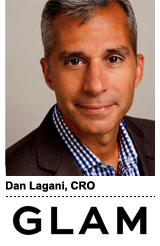 Dan Lagani, the print ad sales veteran who joined lifestyle content network Glam Media as its chief revenue officer and president late last month (read the release), doesn’t feel there is a print vs. digital way of doing business anymore.
Dan Lagani, the print ad sales veteran who joined lifestyle content network Glam Media as its chief revenue officer and president late last month (read the release), doesn’t feel there is a print vs. digital way of doing business anymore.
“Digital has reached maturity, though it’s still early,” he said. “So I don’t even categorize ‘print’ and ‘digital’ separately any more in terms of what the underlying daily issues are that need to be dealt with. It’s all come down to who best creates relevance, scale and targeting.”
Most recently president of North American operations at the Reader’s Digest Association, Lagani has a long track record in print ad sales at Fairchild Fashion Group, Meredith and Condé Nast.
Lagani’s connection with brand advertisers aimed at women appealed to female-focused Glam. And Glam has also been building out its programmatic business, furthered by last year’s partnership on a private exchange with Rubicon Project.
Although Glam won’t say how much inventory goes through its exchange, it’s safe to say that it remains a fraction of its total ad business, which is now more than $100 million annually. As the company prepares for 2014 – which may or may not include a long-expected IPO filing (Glam declined to comment) – the focus will be on how to bridge its programmatic and direct sales sides, Lagani said.
AdExchanger: Why did you decide to join Glam after a career spent at major print publishers?
DAN LAGANI: On the most basic level, what I found attractive about Glam was the simplicity and the power of the platform. If you look at the moment in history we’re at in media right now, Glam is a place where you can connect consumers and brands at targeted scale – and that’s a pretty compelling proposition. Regardless of what comes next in terms of technological developments, being able to achieve targeted scale will remain the most powerful option in media.
How do you see the differences in addressing digital ad sales vs. print?
The lines between traditional and digital media continue to blur. The real question is how do you win in a world where inventory is essentially unlimited? That’s the biggest challenge and opportunity. I define the time we’re in right now as a tech-fueled return to basics. The winners of this moment in media will be the ones who can best answer the question that has always been at the heart of major media: Who is our audience and how are they different from what other brands have?
Print brands have been pressured for many years, from a secular migration in what is engaging readers’ interests – and advertising dollars have reflected that migration. The successful print brands have had to battle for those diminishing dollars for a long time, whereas for most pure-play digital brands, the focus the past few years has generally been on building out the pipeline as demand came through.
What’s the role for programmatic and direct sales at Glam?
Just as there is a role for platforms from desktop to mobile to tablets, it comes down to thinking of the right solution for the right consumer at exactly the right moment. I don’t think programmatic and direct cannibalize each other.
Trying to determine what the right mix between programmatic and direct, and how to blend the two, is a natural focus for the CRO. Over the next few weeks, I’ll be thinking about making sure we’re structured correctly, what additional resources we have. We do have a strong programmatic business, but my first priority is to continue to grow the premium, direct business.
How do you see shaping your role of CRO? Is it more than being the head salesperson?
Every senior executive needs to be a salesperson. Some are selling advertising, while others are figuring out how to engage consumers. But everybody needs to have a sales mindset. As CRO, I’ll have an active sales role. But the difference with this role is not being focused solely on the present. So much change has happened in such a short period of time, and the job of the CRO, particularly in the case of a company like Glam, is to determine the appropriate ways to grow the company further down the line.










